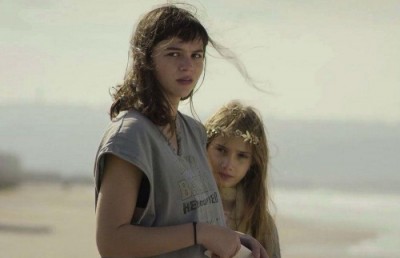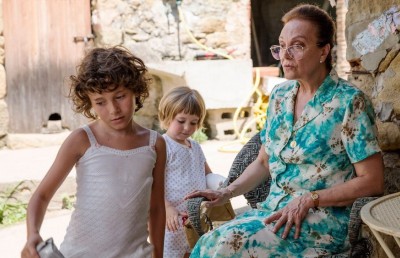FNC 2017: From One Sacred Deer to Another
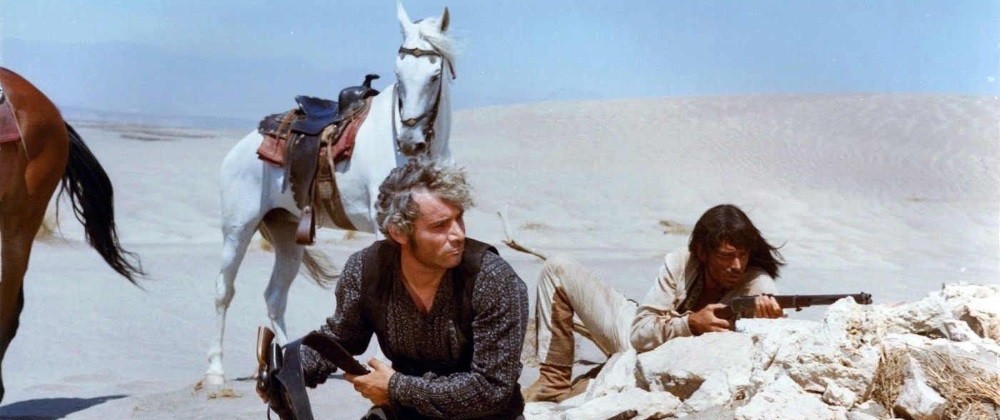
Face to Face (Sergio Sollima, Italy, 1967)
One of the highlights of the 2017 edition of the FNC (Festival de nouveau cinema) was the small spotlight on the spaghetti western. The highlight of the spotlight was the Digital HD restoration of La grande silenzio, 1967, Sergio Corbucci, but since I’ve seen the film many times, and wrote about it here before (link), the film I was most eagerly anticipating was Face to Face, another spaghetti western masterpiece, less stylized than a Leone but more character and dialogue driven with a powerful and nuanced political meaning that demonstrates that in the hands of the right director and committed filmmakers, popular genre in Italy can be socially meaningful. This opens with the rotoscoped colored title sequence that was made famous by Leone and then begins in Boston, representing the Eastern United States, in a university classroom where a tubercular professor Brad Fletcher (played by real life activist Gian Maria Volonté) gives his last class before leaving to convalesce in the West. His University Dean chastises him for not living up to his scholarly potential, which seems to push him toward a destiny he could have never imagined, shifting from a man of books and higher learning to a ruthless, power hungry neo-Fascist who wants to rule an “army of outlaws”.
In the West he meets a half-breed being chaperoned to a jail, an oddly named Solomon ‘Beauregard’ Bennet, played in dark skin makeup and long stringy hair and mustache by Tomas Milian. Milian had just come off his first political western with famous left-winger Sergio Sollima’s The Big Gundown playing his soon to be iconic peasant hero Manuel ‘Cuchillo’ Sanchez. Milian’s Bennet is a distant cousin of the Che Guevara inspired lower class hero. The sophisticated, intellectual Fletcher takes an immediate interest in the well-being of Beau, which causes just enough distraction for him to escape his captors and ride off with Bennet. What follows is a slow transformation, a story that Sollima says is based on what would happen when a man is placed in a new environment and forced to experience a way of life counter to his beliefs. In this case the film follows the slow dual transformation of a good man going bad and bad man gaining a new consciousness (a common character arc in many political spaghetti westerns). One reformation process and one fall from grace.
The film is blessed with some great Spaghetti Western character actors, a film where the title ‘face to face’ can be a reference to the wonderful ensemble of actors. The title is also a reference to the two faces of the nation, East vs. the West, if not the North vs the South, since the film takes place in 1863 during the Civil War. Between these two good vs bad, intellect vs instinct poles is the equally complex character of a Pinkerton Detective agency agent who is playing the spy trying to infiltrate the bandit gang, Charley ‘Chas’ A. Siringo, played by blue-eyed, blonde Austrian-American Helmet Burger. His character is based on a real life infiltrator, Pinkerton Agent Charley Angelo Siringo (Hughes, p. 172), and he too experiences a ‘coming of age’ of sorts, as he slowly comes to loathe the cruel and viscous methods used by the law and well-heeled (i.e. industrialists, wealthy capitalists) members of society. The script is rife with some captivating lines, some funny, some brimming with social message. When Siringo tries to convince Beau to take him into his gang he shows him a pile of fake “wanted” signs and says, “These are my references.” The motley gang of lost members of society who are holed in the hidden anarchist community nestled among the mountains they call Puerto Del Fuogo (door of fire) are referred to as “the dregs of the old romantic frontier” and “ghosts from the past”. One of the most interesting of the faces on display in the Puerto del fuogo gang is the teenage girl infatuated with Beau, the spikey haired Cattle Annie, played by the French actress Carole André, who later appeared in Death in Venice, and The Bloodstained Butterfly.
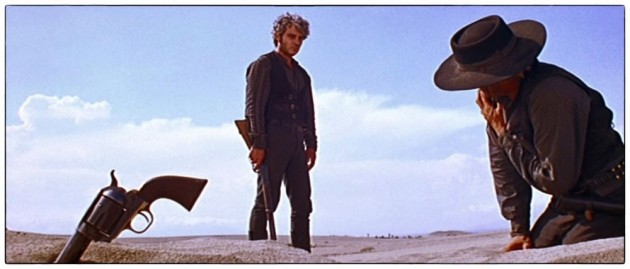
Bennet is at first charmed by the care-free, rule-free, classless nature of this society –the haphazard manner of the shooting style of a dance scene early in his stay is reflective of this. When they are referred to as “ghosts” he replies that he has “never seen anyone more alive” than them, alluding perhaps to his own past and ill health; but once he becomes obsessed with fulfilling his own destiny, the one his Academic Dean in Boston said he had failed to achieve, he sees them as “morons” he can use as pawns to form his “army of outlaws.” His refrain here is the closest it comes to the Fascist allusions critics have made, and which are not uncommon in spaghetti westerns (see Giulio Questi’s same year Django Kill… If You Live Shoot!, 1967, which stages the lynching of a character in the town street to look like Mussolini’s death at the hands of partisans). When Bennet confronts his equal, another educated man from the East out for profit in the west, Wallace, he tells him, ”Beyond the confines that limit the outlaw as an individual, violence by masses of men is called history.” Here we can see the influence of The Good, the Bad and the Ugly, where Leone mirrors the killings of a few bounty hunters with the massacre of the Nation in the Civil War. But some critics, such as Kevin Grant in Any Gun Can Play, (p. 205-206) see the play between Beau and Bennet within the recent history of European politics and the rise of Fascism. In this reading Beau is an analog for Italy, allowing the civilized Bennet, representing the Germans, into his fold and then slowly becoming usurped by the more damning, single-minded power hungry Fascist drive. Even the Civil War is brought home in the brief scene where Beau visits the plantation of De Winton’s, where the woman, Maximilian de Winton (Angel Del Pozo), the aristocratic sister is adamant that no one, not even that “Lincoln” will stop her from her slave trade. But the Americans are not excluded from Sollima and writer Sergio Donati’s stinging criticism. The care-free society of Puerto del Fuogo is paralleled by the burgeoning society in the town “Purgatory City,” which has established law but one which is at the service of a corrupt sheriff and the interests of two competing business men. When Bennet returns to the anarchist hold and changes their outlook to one of power and profit and convinces them to storm the city for money they can use to strengthen themselves, the city’s authorities use this rising vigilantism to squash what they see as a potentially dangerous anarchist community. They instruct Siringo to lead a posse out to Puerto del fuogo to stop any more unjust violence and bloodshed, to which Siringo replies, “that’s the kind of speech they make in Washington just before they decide to send the army out to massacre the Indians.” In another potential America reference, the presence of these educated men from the East out for power and money, Bennet and Wallace, can be seen as a direct analogy to the Northern Carpetbaggers, who went to the South after the Civil War for opportunistic purposes tied to the intent to reform and democratize the South. As noted, the film is stylistically more subdued than the operatic elements of Leone or gothic quality of Corbucci, relying on dramatic compositions favoring diagonals and fluid camera movements that often encircle characters and reveal off-screen subjects that are dramatically relevant to the scene, like a camera move that dollies around Bennet to frame Maria in a window. The finale is, in keeping with the point of a more muted style, a miniature version of the epic finale of TGTBAU, a three-way showdown set in the desert between different moral forces, the once bad and now turned good Beauregard Bennet, the once good now turned bad Brad Fletcher, and the man in-between, Pinkerton Agent Charley Siringo. Brad tries to convince Bennet that together they can become an unstoppable force, so wants to shoot the injured Siringo, who used his status and cunning to convince the posse to retreat from hunting down the remaining members of the Del Fuogo community (mainly women and children). Bennet shoots Fletcher dead, who seems shocked and asks him, “why?”, to which Bennet replies, “It felt right.” Will Siringo force Bennet into his charge and escort him to the authorities? Sickened by the actions of the so called lawmakers, and realizing how Bennet has changed, he turns to fire rounds into the face of a dead member of the posse. He tells Bennet that no one will recognize that man now and he will take him in as if Bennet, telling him that “The old Bennet does not exist anymore anyway.” Like the Leone classic, the bad is killed, leaving the two morally more righteous characters to continue on with their life
Outrage Coda (2017, Takashi Kitano, Japan)
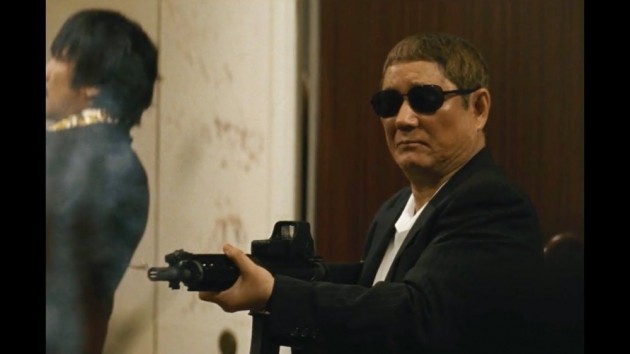
Tough hombres, guns and violence, regular features of the Western are also, part and parcel of the Japanese yakuza film. Outrage Coda is the last in a Yakuza trilogy (Outrage, Outrage Beyond, Outrage Coda ), where Kitano plays a yakuza leader named Otomo, a well-heeled ex-Yakuza laying low on the Korean island of Jeju, working for a major Yakuza player in Korea, Mr. Change, (Tokio Kaneda). The story is straight forward but the yakuza family machinations get complicated. It all starts with a young upstart yakuza, the blustery type Hanada (Pierre Taki), complaining about a prostitute under Otomo’s management. Hanada roughs up the prostitute and Otomo demands compensation. When Otomo sends someone the next day to collect the promised money, he is shot dead by Hanada and splayed on the beach. With this breach, Otomo and his lieutenant Ichikawa become men on a mission. The film (as is the trilogy) is brim full of stock gangster and yakuza characters that comprise the tough yakuza cinematic universe. Otomo becomes a one man wrecking crew in an all-out clan warfare, killing all (or almost) the gang members in the Hanabishi -kai clan, who is led by the always wide—eyed Nomura (Ohsugi Ren).
Written and directed and edited by Kitano this one feels more mainstream than his other films, with a more reserved style, though the violence still happens in bursts. But if your idea of fun is hanging out with a variety of Yakuza types for 100 minutes, this is it. Compared to Italian mafia, the yakuza seem to have less fun. Hardly any smiling, and very much business as usual. Only Kitano breaks a half-cocked smile once in a while. Otomo may be nuts but he seems to have a semblance of a moral code and a dedication to novel ways of killing. One leader gets buried to his head and decapitated by Otomo’s car. Another yakuza leader has a mouth bomb set off by a long trigger wire, as he lies tied to the bed caught out during a SM session. Otomo’s code is so chivalrous that when Chang sends someone to kill him because he can’t risk having such a time bomb upsetting friend and foe, Otomo shows his respect for Chang by telling the hired gun that he’ll take care of Chang’s problem. In the yakuza universe the less said about women, the better (for tough, subversive wild cats I direct you to the Female Scorpion Convict films of the 1970ss). Kitano includes two hapless Japanese cops, detectives in the yakuza crime division, who are treated with contempt by the yakuza, who have all but castrated the cops. The younger detective who still clings to has ideals, ends up handing in his resignation. Clearly the law has no place in the cine-universe of the yakuza.
The Florida Project (Sean Baker, 2017)
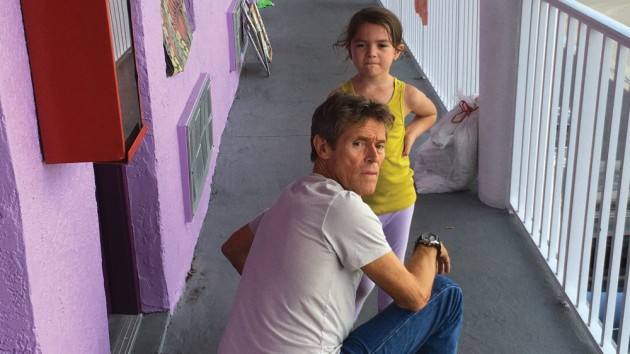
The Florida Project (Sean Baker, 2017) reminded me of a film from last year’s FNC, American Honey, with its sense of naturalism, both in the philosophical and aesthetic sense, with people being conditioned by elements beyond their control –genetics, health, mental state– including here class. It feels much like a contemporary American take on neo-realism, with a feel that is very different, because of its lighter tone, but bearing many superficial similarities: importance of child characters, mix of pro and non-pro actors, real location, episodic narrative, and ambiguous ending. In its gorgeous treatment of natural light and stylized framing –filmed on 35mm except for the concluding scene– and depiction of low life, The Florida Project recalls Welles’ comment after seeing La Terra Trema, grumbling that Visconti shot his fisherman like Vogue models. Here too Baker tends to fall in love with creating picturesque moments out of the misery of the loser mother Halley (Bria Vinaite) and her rambling, innocent daughter Moonee (Brooklynn Prince), shooting them in one gorgeous magic morning scene, or with sunlight flaring the lens, a rainbow arching over the motel (a real rainbow, captured by sheer good fortune), watching fireworks cutting into the night sky, and dancing in a rain soaked meadow. Even the tacky wide angled commercial behemoths, Orange World, Twisty Treatee, Gift Shop, are graced with a certain poetry of failed funhouses. Even the Magic Castle Inn, next to Futureland Inn, is painted in a bright pink that suggests fun and fancy. Yet the sordidness of the place is brought home in a hilarious scene where a honeymooning Brazilian couple are mistakenly booked into the motel, and the wife is horrified at even the thought of staying one second in what she calls a “gypsy project.”
In the opening scene we meet Halley’s six year-old daughter Mooney and her friend Scooty (Christopher Rivera), who are never too far from a prank, insult, or minor crime. Mooney, Scooty and their siblings and family live in a low rent motel a hop scotch and throw from Disneyland, managed by a well-meaning but one straw away from breakdown, Bobby (Willem Dafoe). Their first inappropriate act is to spit onto another resident’s car from the first floor landing. The owner of the car, an Hispanic mother of two, one a same aged girl named Jancey, gets upset at the disgusting gesture and brings the kids to Mooney’s mother Halley to report on the incident. She expects the mother to reprimand her daughter. More out of boredom than a sense of right, Halley forces her daughter to clean the car, but what starts out as a dutiful punishment ends up being, as the offended mother says, “too much fun,” Mooney even getting Jancey to help clean her mother’s own car! The film plays off the innocence of these children, who know no shame because they have yet to be socialized, and live a life still sheltered from the harshness of their reality. They routinely fake sad stories to panhandle enough money for a single ice cream cone, which they gladly share between the three of them, taking turns at slurping a mouthful of the ice cold treat.
Some of the kid pranks go too far. When Mooney Ashley (Mela Murder) prods Scooty into setting an abandoned hotel in flames –providing some much-needed entertainment for the motel regulars– Scooty’s mother Ashley (Mela Murder) lays down the law and prohibits her son from hanging out with Mooney. When Halley confronts Ashley about her imposed restrictions and Ashley chastises her for bringing prostitution into the motel community, Halley attacks and beats her viciously. The violent act, which alienates her best friend and ally, demonstrates just how volatile and irresponsible Halley’s behavior can be, and the potential danger she poses for her daughter (as well meaning as she usually is).
One thing is certain, the one character who is always grounded is the poor sap motel manager Bobby, played with earnest humility by Willem Dafoe. Dafoe’s Bobby is a model of patience and common sense. While he pledges his allegiance to his boss who pays his check, and abides by his set of rules, he also has great empathy for the luckless and sorry occupants of the motel. He knows them all by name, protects them from all threats, including one scene where he diverts a pedophile lurking around the hotel and tells him to leave and never return. Bobby is a genuine person, with real heart and compassion for the welfare of others. We learn nothing about Robby, who he was or how he came to this job, but he feels real and authentic. He even speaks to the storks who have wandered off into the motel driveway, asking them politely to leave.
The question that critics will ask: is this a case of Baker exploiting these sad characters with real life horror problems, or is he just giving them their justified moment of grace or just plain humanity? Much of this comes to a head in the ambiguous and possibly problematic ending. Halley is a low rent master of the scam. Selling wholesale purchased perfume to tourists as she loiters outside a nearby hotel; accepting free food from her motel single mother friend Ashley, who works at a Waffle Restaurant; selling amusement park bracelets to a tourist and then stealing it from him, and other pathetic attempts at earning income. Halley’s one step ahead of disaster catches up to her when she resorts to prostituting herself in her motel room for rent money. This part of the story is handled with real visual sophistication, as Halley’s idea is transmitted to us when she feigns “bikini selfies” with her and her daughter, using the sexy photos of herself to advertise on escort sites. The sexual exchanges themselves occur off-screen, replaced by long scenes of Mooney playing in the bathtub, the only way that Halley could have kept her daughter safe while diverting her daughter from the sordid scenes. When a man she serviced returns claiming she stole something from his bag, Halley denies everything and Bobby diffuses the situation, even though he suspects Halley is guilty. When this catches up to the local social services, agents and the police come to take her daughter while Halley deals with the criminal charges against her. The social workers let Mooney slip past them into the dangers of the nearby streets, as she makes her way to say goodbye to her best friend Jancey.
Once the reality of her mother’s situation is made apparent, Mooney opens up her soul and reveals her tender years as she cries telling Jancey (Valeria Cotto) that this will be the last time they see each other (is she more disturbed at this than the thought of not seeing her mother again?). As a response to Mooney’s painful admission, Jancey takes her by the hand and runs off to take her somewhere “special”, leading to the film’s ambiguous ending. The film shifts into a staggered, step-printed camera movement, with uplifting music. Visually, Baker abandons the sensual, gorgeous 35mm film stock for the more garish, color saturated iphone aesthetic he made famous in Tangerine. Slowly Mooney and Jancey make their way through the familiar landscapes until arriving at their destination: Disney Land, home of youthful magic, adventure and fantasy. How does one read this ending? On the surface you can see Disney World as the saviour for these poor children, who have had their own innocence compromised by poor parenting and poverty. Isn’t Disney World and all it represents just an escapist vehicle for their ills? And in fact, the root of the problem (offering pure fantasy for real life problems)? Or is this an ending to equal the fantastical ending of Miracle in Milan, where the poor denizens who have been gentrified out of their hovel by land developers take to the heavens on their magic brooms? If the greatest of neo-realists, Vittorio De Sica and Cesar Zavattini, can send their disenfranchised and poor directly to the ultimate land of fantasy, heaven, can’t Baker do the same by sending his poor innocents to the childhood version of heaven, Disney World? Or echo the collective balloons of Paris that take the imaginative boy who befriended a red balloon skyward to the heavens at the end of the children’s classic, The Red Balloon (1956)?
Thelma (2017, Joachim Trier, Norway)
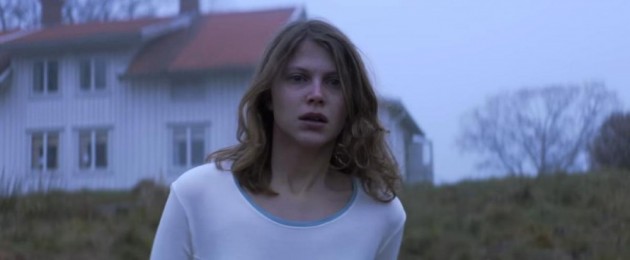
Eili Harboe as Thelma
One of the best of the fest was Thelma (2017, Joachim Trier, Norway), a psychological horror film with an assured sense of formal control and a thought provoking thematic core: how does a family cope with a torturous? How does a family cope with a severe blow, like a child with a debilitating birth illness, or the loss of a child? This is one of the themes in this film, where a Norwegian family with a beautiful, self-controlled (apparently) daughter, we slowly learn has a core of a problem so intense that it can only be dealt with by herself, from within. There is no help outside the family for this problem. Which is why Thelma works on so many levels. It is a psychological horror film, a supernatural horror film, a family problem film, and a lesbian romance. In the tense opening scene which sets up the dilemma without revealing it, a father Trond (Henrik Rafaelsen) is out hunting on a frozen lake with his young daughter. An overhead shot shows us fish just below the frozen surface, a metaphor for things just below one’s consciousness and a striking visual motif that will govern the film’s central theme of repressed urges and powers nestled within Thelma’s mind, like flora submerged under water, struggling to rise above the surface. They get to the woods where Trond aims his rifle at a deer in the woods; he slowly shifts his rifle to point at his daughter’s head, who is a step ahead and oblivious to the apparent risk, and keeps it there for what appears an eternity. The father reconsiders and drops the gun, allowing the deer to escape and daughter to survive, a decision which will eventually cost him his life. But what father would have the courage to fire at their daughter, regardless of the reason and consequences (Damien’s father)?

Anja (Okay Kaya) and Thelma
Trond (Henrik Rafaelsen) and his wheel-chair bound wife Unni (Ellen Dorrit Petersen) have raised Thelma ( (Eili Harboe) in a strict, religious household, but allow her to leave home for university –while still maintaining a close watch on her activity through constant phone calls, messages and visits. Away from the total grip of her parents, Thelma begins to express her supernatural powers of psychokinesis when she meets a beautiful woman she is attracted to, Anja (Okay Kaya). Thelma begins to experience violent seizures and reveals a power so frightening that it explains the opening scene: as her sexual lust for Anja is awoken so too is her ability to control the world around her, to the point where she has superhuman powers to control minds and alter the physical world. When she first meets Anja in the library, she falls to the floor with a seizure and a flurry of crows crash into the library’s huge glass windows like Kamikaze pilots. Psychologically, the seizures and psychokinetic powers are a symbolic manifestation of repression (religious, sexual/lesbian, social), which aligns Thelma with the ‘monstrous’ feminine archetype, going back to Irene in The Cat People, whose jealousy over a man causes her to transform into a leopard. What’s frightening about Thelma’s power is that she has little or no control over it, as it seems to stem from her deepest inner desires (here it recalls the wish fulfilling Room in Stalker, which people are afraid to enter because it delivers your deeply buried wish, not what you think you desire). The direction, with taut montage and rich musical strains, plays the tense and frightening potential of scenes off against the sexual desire, loneliness and alienation felt by Thelma, which makes it an original and compelling approach to horror.
Two other highlights of the FNC reflected the past and the future: a 35mm print showing of Near Dark (1987, Kathryn Bigelow) and the 2017 heady locally produced zombie film, Les Affamés (Robin Aubert, 2017, Canada). I will surely revisit this intriguing horror film for a future review in Offscreen, but for the purpose of this report I will just note some odd synchronicities between Les Affamés and another Quebec-directed film, Blade Runner 2049 (Denis Villeneuve, 2017). Similarities you ask? In a Facebook post the day after these two films screened, Offscreen writer Randolph Jordan posted that he had just seen a Quebec zombie double bill, with Villeneuve as the Quebec contact in the big budgeted Hollywood spectacle, and replicants as zombies. But there are more similarities. Narratively both Les Affamés and Blade Runner 2049 begin in medias res, with the story in mid flow, with no concessions made on how we got to where we are: no clue on what caused the zombie crisis; and no clue on how the replicants can now procreate, and whether BOTH male and female need to be replicants (which would make Deckard undoubtedly a replicant, since he fathered the woman being searched for in this film). This latter is a BIG ask, since the big question hovering over the first film –is Deckard a replicant– is never really answered, although most pathways lead to yes. Another interesting parallel is the mountain high piles of domestic debris that the zombies routinely and ritualistically convene around in Les Affamés (a visual image which was probably lifted or influenced by the Walking Dead series).
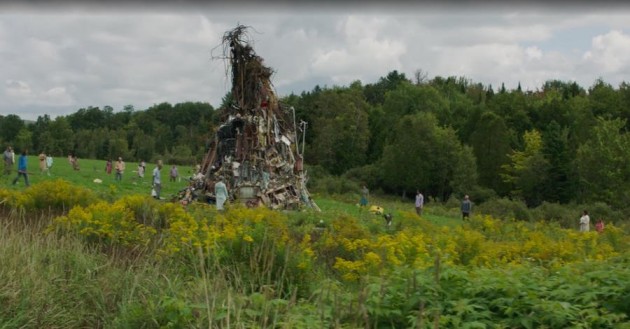
Les Affamés
In Blade Runner 2049 the city centers are also interspersed with pockets of waste dump sites, like in Wall-e, where a planet is the depository for old unused and broken robots (recalling also the junkyard island in Isle of Dogs). Though in Les Affamés we are never told who builds these heap piles and what purpose they serve, other than apparently keeping the zombies in a calmed state. And both films end with most of the major characters dying, and the two remaining survivors being surrogate or real father-daughter figures, the young girl and Nascar rider from the opening in Les Affamés and Deckard and his daughter in Blade Runner 2049. Blade Runner 2049 is an odd palimpsest replica of the original, with much of the film’s characters and themes (but strangely not the visual style) either riffing on the original or altering it in some slight way, amplifying or reducing it. The music is at times an amplification of the original, louder, meaner, rougher, or a subtle repeat of a leitmotif. Deckard is back but much older. And Gosling is a perfect response to the bland, unexpressive original Deckard/Ford. Jared Leto replays the reclusive genetics genius portfolio of Joe Turkels’ Dr. Tyrell, Niander Wallace, but Leto, as impressive an actor he can be, cannot ‘replicate’ the ‘Frankensteinian’ presence or darkly sadistic nature Turkel provides. Leto is Christ like with his hair and milky eyes and lives in a golden waterlogged swimming pool like chamber. His brilliance is offset by his symbolic blindness. Turkel brings a mixture of humanity and earnest megalomania that makes his character for more threatening than Leto’s one note sinister. And even Sean Young as the angelic Rachel returns as her younger self thanks to eerie facial CGI technology which rejuvenates the now older actress (further proof that Hollywood has problems letting women look old, or older). Her first appearance is, I believe, the actual footage from the original inserted into Wallace’s space, while the second instance, where she interacts with Deckard, we see that she is Young and not-Young (even Deckard notes, her eyes are not the right color). Hollywood is OK with men getting old, so Edward James Olmos returns as his older self, Gaff in a single scene where he produces wooden memory tokens, instead of the aluminum ones of the original. And the final scene, where the wounded (knifed in his side) ‘K’ lies backside on the snow-capped steps, then framed from above to underscore the falling snow, is a replay of Roy Batty’s prophetic rain-soaked death. ‘K’s’ death is uncertain, and the uncertainty reminded me of the end of Drive, where Gosling’s character also seems to die from a knife wound inflicted by bad person gangster Albert Brooks, but magically resurrects and drives off into the sunset (like the ending of the original Blade Runner oddly enough).
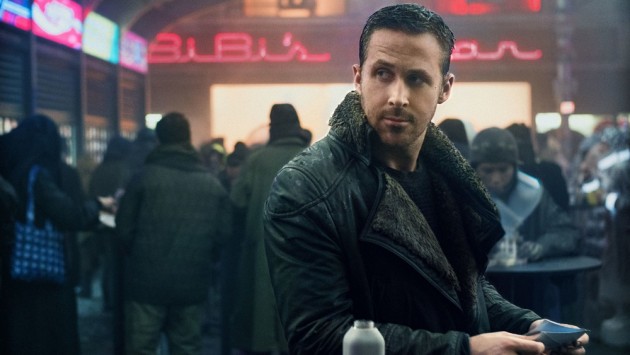
Blade Runner 2049
FNC celebrated the relatively young career of the Belgium husband and wife team, Hélène Cattet and Bruno Forzani, whose short and feature films have played in Montreal before (at Fantasia or FNC) and have also been covered in this journal. Their latest film is a turn away from their usual giallo inspired reverie to the crime genre, Laissez bronzer les cadavres. The film is just as bound to formal experimentation as their previous works, but leans far more into the terrain of surrealism/absurdism and psychedilia than their previous works, with the titular gold spilling out into the film’s mise en scene as well as the bohemian nature of writer and painter couple Bernier (Marc Barbie) and his muse, Luce (Elina Löwensohn). It also feels different for being set entirely in an inhospitable exterior mountain location, recalling the scenery of The Treasure of Siera Madre. If truth be told, with only one viewing under my belt, and not having read the source crime novel –which apparently makes it somewhat more feasible that you will be able to follow the dizzying narrative breaks as the single set showdown between criminals, innocents and police draws itself out into a harrowing spiral of a montage– I found this one harder to lose myself in their other works. Perhaps a second screening will reveal other secrets and joys.
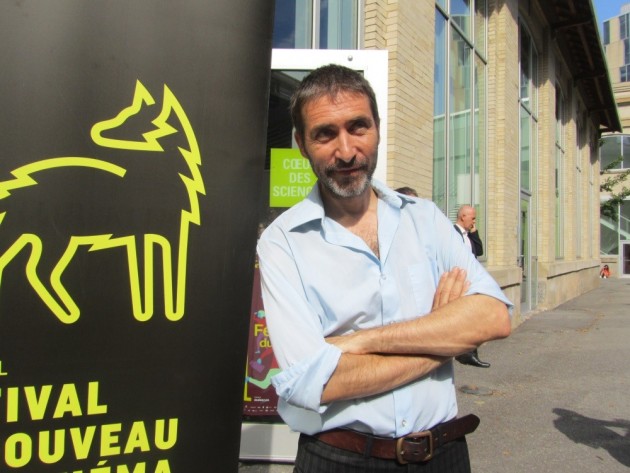
Julien Fonfrède, programmer of the always edgy Temps 0 section
I used the retrospective of their work to catch up with a big theatre screening of their previous film, The Strange Color of Your Body’s Tears (2013). Each shot in this film is like a call out for pure cinema. Or more properly expressed, a fetishization of cinema. After the wonderfully stylish Amer I didn’t think these two could make a film more brazenly flippant with narrative protocol and stylistically experimental than Amer, but they surely have. The Strange Color of Your Body’s Tears is Amer blended with Persona, a film which over the years is becoming far more influential than it ever has. A man, Dan Kristensen (Klaus Tange), comes home to a missing wife. He asks around the building complex as to her whereabouts but to no success. That is it for the plot. Things are him, include physical and mental space begins to fragment and splinter into kaleidoscopic shards. The film becomes an exploration of Kristensen’s art nouveau building space, and the traumatic memories that appear sourced from his own traumatic history with women. The style contains a looping effect where actions appear stuck in a hypnotic loop (Kristensen repeatedly getting up to answer the phone, musical refrains, etc.). Much of the imagery is hidden in extreme close-ups, a man being jabbed, slashed, slit, punctured by a blade, disorienting and dizzying in its drive. Like Persona Kristensen begins to split his identity. His wife is named Edwige (after the great giallo actress Edwige Fenech), but the layers of women who he sees, thinks about, fetishized as a boy, and collects in a scrapbook are repetitions of Laura, perhaps a white woman, perhaps a black woman. Identity and memory remain blurred.
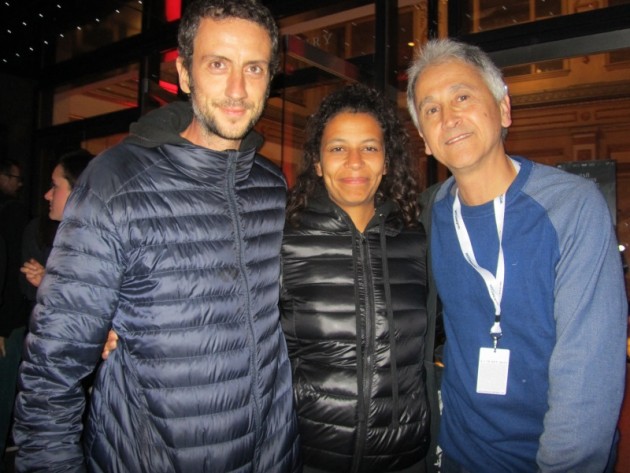
With Bruno Forzani and Hélène Cattet
I’ll conclude my report with the uncompromising The Killing of a Sacred Deer (2017 Yorgos Lanthimos), the new film by Greek arch formalist Lanthimos, can best be described as harrowing, harrowing and harrowing. Lanthimos creates a world where every aspect that is not directly a part of the characters is stripped or bracketed out. So as his two main characters, played by Colin Farrell and Nicole Kidman, are both upper middle class doctors, the world we see is one of glossy white spaces, trendy homes, and people whose lives depend on the medical industry. If the film has a moral, it is very old testament, and states quite clearly that if a person makes a mistake in their life, they need to come clean. If you don’t the mistake will come up and bite you horribly in the face. Which is what occurs to cardiologist Dr. Steven Murphy (Farrell), when a lapse in judgement causes him to lose a patient on the operating table. This event is one that has already happened when the film begins. Perhaps against his better judgement the doctor enters into an uncomfortable, ill-conceived social relationship with that unlucky patient’s 16 year-old son, Martin (Barry Keoghan), a socially awkward teenager who houses a rigid internal drive for payback. From this moment on Murphy’s world begins to crumble. 1 .
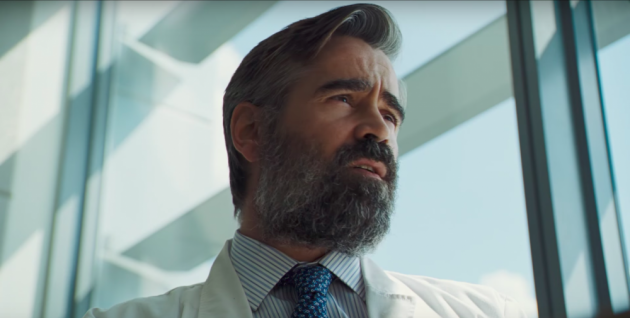
Colin Farrell in The Killing of a Sacred Deer
Lanthimos, through his controlled style, with slow zoom shots, wide angle lens for static frames, and stolid camera movements, in essence traps his characters into an inevitable physical space which, as wide or spacious it may be, leads only to one door. The Murphy’s life seems idyllic, or at least very controlled, with young son Bob (Sunny Suljic), 14 year-old daughter Kim (Raffey Cassidy), mother Anna (Kidman) and Dad interacting as a cardboard cut-out family: perfect looking but stiff and formal, with a quite reticence. The intrusive presence in their lives, Martin, played by relative newcomer Barry Keoghan, has an unexplained ability to project his vengeful will on those around him. And only he knows what ghastly events will unfold if they do not comply to his Old Testament Biblical wish of swapping an eye for an eye. The consequences which seem to be controlled by Martin are that if Murphy does not choose one of his family members to kill in exchange for his father’s life, they will each die a similar slow death where they become paralyzed and unable to walk, stop eating and then bleed from their eyes until they die (the stigmata perhaps another reference to the Bible). When Bob is the first to have these symptoms, the father enlists the best doctors and tests that his status can afford. But the tests are all negative. There is nothing physically wrong with the boy, an action that made me recall the similar plot point in Red Desert, where Giuliana’s (Monica Vitti) son all of a sudden loses his ability to walk, perhaps a symptom or empathetic gesture with her mother’s alienation. The mother becomes nearly hysterical, but luckily the boy’s legs return to him. In both films there are characters in sterile work spaces who are unable to forge a life outside it. The Killing of a Sacred Deer thrusts the viewer into its uncomfortable spaces right from the opening with its most intensely revulsive shot: an extreme close-up of a living , exposed heart, pumping. The camera zooms out to reveal we are in an operating theatre and the heart is inside an open body cavity, fitted to be operated on. The image becomes metaphorical, to quote Martin, reflecting the way that Martin has in effect the doctors heart in his own hands. Why exactly Steven begins an unhealthy relationship with Martin is unclear, but it soon becomes revealed that it is one fashioned from a sort of blackmail. Martin is like the docile Devil who wields his power with undue passiveness. Even when the children begin to suffer the illness Martin had predicted, the children appear calm and unfussed by their new restrictions, calmly accepting their role in their father’s moral quagmire. The wife Anna is pretty much a living dead (another ‘zombie’), playing to her husband’s ice chill demeanor, which extends to the bedroom, where it appears Steven can only perform if Anna plays like a patient lying still on his operating table. In a sense, Lanthimos extends the metaphor of the operating theatre outward to the world around the two doctors. Once Steven commits the inevitable arbitrary murder, Lanthimos lays on the poetic irony thick by playing the beautiful Bach prelude used by Tarkovsky at the end of Mirror (1975). Lanthimos is also a deadpan comedian in another life, as Scared Deer had me chuckling more than a few times to what can best be described as very black humor.
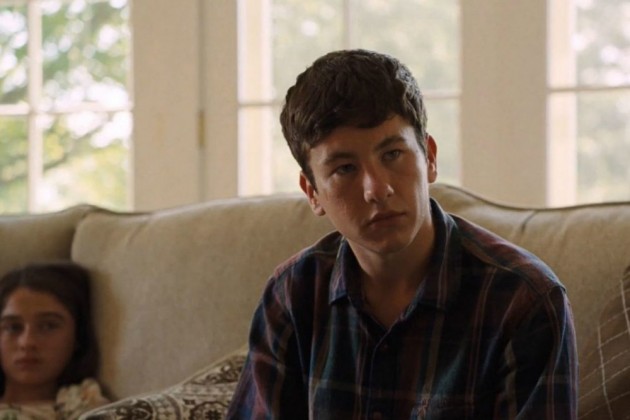
Barry Keoghan in The-Killing of a Sacred-Deer
Kevin Grant. Any Gun Can Play. FAB Press, 2011.
Notes
- The story of an ideal doctor’s life that takes a quick turn for an inevitable fall to hell because of an unruly patient (or relative of) recalls Probleme D’infiltration (Robert Morin, 2017). ↩



